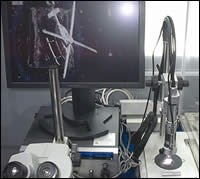JIMTOF Puts Nanotechnology Under Magnification
The big theme at the Japan International Machine Tool Fair (JIMTOF) was nanotechnology—the ability to produce parts to submicron accuracy.
The big theme at the Japan International Machine Tool Fair (JIMTOF) was nanotechnology—the ability to produce parts to submicron accuracy.
How does the JIMTOF experience compare to that of the International Manufacturing Technology Show (IMTS), North America’s premier machine tool and manufacturing technology show, which took place just 2 months before the event in Tokyo? IMTS tends to be more colorful (see box below), but JIMTOF tends to follow a unifying theme that gives it a certain coherence.
Down To The Millionth
The sponsors of JIMTOF 2004 apparently chose nanotechnology as the major theme for last November’s show. Numerous exhibitors complied with the choice. With medical and electronic industries creating challenging demands for manufacturers around the world, nanotechnology seems to be a timely choice. Nanotechnology has several meanings, but at JIMTOF 2004, it referred to submicron accuracies—that is, accuracies under 1 micron (one millionth of a meter) or less than 1/40 millionth of an inch. Machine tools capable of such extreme accuracy may be applied to microscopic workpieces (micro-machining), but they are more typically applied to workpieces with features and details measurable in submicron increments.
Almost all of the major machine tool builders in Japan displayed at least one machine described as using nanotechnology. This was often reflected in the model name: Nano Mycenter, Nanotech, RoboNano and so on. Micro, Super, Hyper and Mega is also used to designate machines in the nanotechnology category. Although vertical milling machines were the most common machine category described by nanotechnology, various models of lathes, grinders and electrical discharge machines were also given this label.
A milling machine with nanotechnology capability is likely to have many, or all, of the following features:
- linear motor drives in the major axes
- hydrostatic ways
- some means to compensate for or eliminate sources of heat
- very high speed spindles (40,000 rpm and higher)
- granite base and/or column
- laser-based position feedback system
- CNC unit capable of processing and displaying nanometer units
- non-contact cutting tool detection or measurement system
A favorite demonstration of nanotechnology in milling was a finely detailed mold cavity for plastic injection of a miniature electrical connector or medical testing device. Workpieces featuring complex arrays of holes (as small as 0.01 mm) were also conspicuous. Mirror-like finishes produced solely by milling were also prominently displayed. Many of the sample workpieces produced by nanotechnology machines were shown under microscopes or powerful magnifiers.
In lathes, nanotechnology allows turning operations to produce finishes as fine and as accurate as those associated with high-end grinders. And for grinding, nanotechnology means producing workpieces with mirror-like finishes without polishing.
Nanometer Interpolation
Machining to submicron accuracy is dependent on advanced control unit technology. A good example of how CNC developers are responding is Fanuc, whose Series 31i CNC was a popular choice for the nanotechnology machines displayed at JIMTOF. This control features high speed processing to support capabilities such as nanometer interpolation. Nanometer interpolation means that axis moves programmed in micron units are calculated in nanometer units for smoother, more accurate contouring moves. According to the company, the advances in this control unit have enabled eight times faster interpolation cycle time compared to previous models, as many as 1000 blocks of look-ahead for high-accuracy contouring and 0.4 millisecond block processing time. High resolution encoders (16 million pulses per revolution) also contribute to machining accuracy.
At the show, Fanuc also demonstrated its “nano-smoothing” feature for five-axis machining. Previously available for three-axis machining, five-axis nano-smoothing allows the control unit to process NC programs as if they were generated by CAM software with NURBS output (curves instead of line segments). The result is contouring to a much tighter tolerance in chordal deviation. In other words, the actual path of the cutting tool more closely matches a smooth path defined by motion commands rather than a series of closely spaced linear moves. Surfaces produced on the workpiece are visibly smoother, largely free of cusps and ridges produced with conventional machining. Nano-smoothing works with all five-axis functionality including tool centerpoint, tool radius and tool length compensation. Fanuc technology is available in the United States through GE Fanuc Automation (Charlottesville, Virginia).
Cutting Tools Too Small To See
The end mills and twist drills used in nanotechnology applications are proportionately tiny. A number of cutting tool manufacturers in Japan offer cutting tools in diameters as small as 0.1 mm and specials as small as 0.03 mm. Although cutting tools this small are almost invisible to the naked eye, correct procedures for their effective use must be ensured. Speeds, feeds, depths of cut, coolant application and chip evacuation are issues that require attention, just as they do in any machining operation.
However, because nanotechnology applications represent a new frontier, there is no accepted body of knowledge about setting the machining parameters for tools this small. Users are largely compelled to find what works by a process of trial and error. This know-how then becomes a closely guarded secret. As one machine tool builder observed, nanotechnology customers typically do not describe what they are doing; they only ask questions.
Advice from a cutting tool supplier indicated that experimenting with extremely small cutting tools often relied on counterintuitive adjustments. Increasing cutting speeds and/or depth of cut produced better results than the opposite approach. Likewise, a longer cutting tool was sometimes shown to resist breakage better than a shorter tool.
It is well understood that vibration is the main enemy of extremely small cutting tools. Preventing vibrations that originate outside the machine from reaching the setup is one strategy. Eliminating vibrations that originate within the machine is another. Collets, toolholders and spindle interface systems that minimize tool runout are proving to be mandatory. Several builders are developing spindle designs that provide high rotational speeds and extreme stiffness so that very low runout is experienced at the tool tip.
Cutting tool manufacturers and machine tool builders are actively researching the dynamics of machining with extremely small tools. Recommendations and useful machining data to cover a variety of nanotechnology applications are not far off.
The growing importance of machining with very small cutting tools is evidenced by the priority that cutting tool manufacturers in Japan are giving it. A number of companies specializing in small cutting tools are emerging. Established companies such as OSG Corporation are expanding their offerings in this range as well. OSG reports that sales for end mills and drills smaller than 6 mm in diameter is one of its fastest growing categories.
OSG’s carbide and end mill factory has a special section set aside for cutting tools under 3 mm in diameter. This part of the factory is environmentally controlled and houses banks of grinders especially designed for producing extremely small cutting tools. The company maintains a testing facility with a number of late-model machine tools on which to perform testing to support customer applications, including a growing number that involve very small cutting tools in micro-machining and nanotechnology. Because these applications are so diverse, specific recommendations for machining parameters are being formulated on a case-by-case basis.
Nano-Measurement
Being able to inspect and measure workpieces in the nanotechnology field is not to be neglected. Mitutoyo’s booth gave some indication of what to expect. The company was showing the Nanocord, a system for measuring very fine forms and dimensions such as MEMS (microelectromechanical systems) parts, precision molds for subminiature electronic components, aspherical lenses and microscopic holes. The system uses a vision probe for non-contact measurement or contact probes with a stylus as small as 15 nanometers in diameter. An ultra-low measuring force probe for scanning is also available. As you can imagine, the resolution of these various accessories is given in fractions of a nanometer.
Read Next
Registration Now Open for the Precision Machining Technology Show (PMTS) 2025
The precision machining industry’s premier event returns to Cleveland, OH, April 1-3.
Read More5 Rules of Thumb for Buying CNC Machine Tools
Use these tips to carefully plan your machine tool purchases and to avoid regretting your decision later.
Read MoreRego-Fix’s Center for Machining Excellence Promotes Collaboration
The new space includes a showroom, office spaces and an auditorium that will enhance its work with its technical partners.
Read More











.jpg;maxWidth=300;quality=90)









.jpg;maxWidth=300;quality=90)






